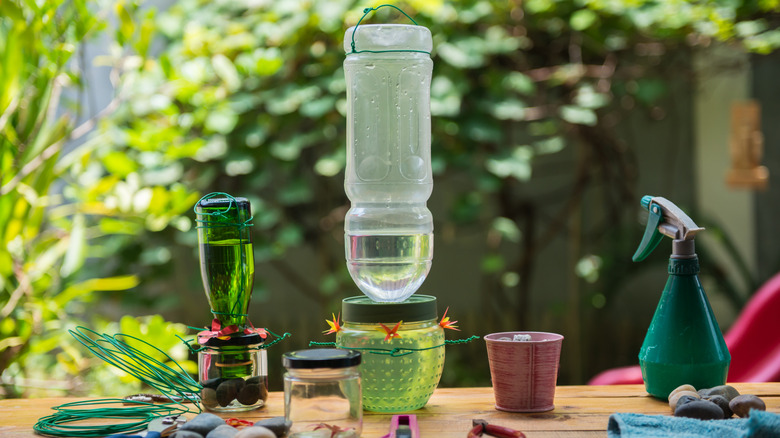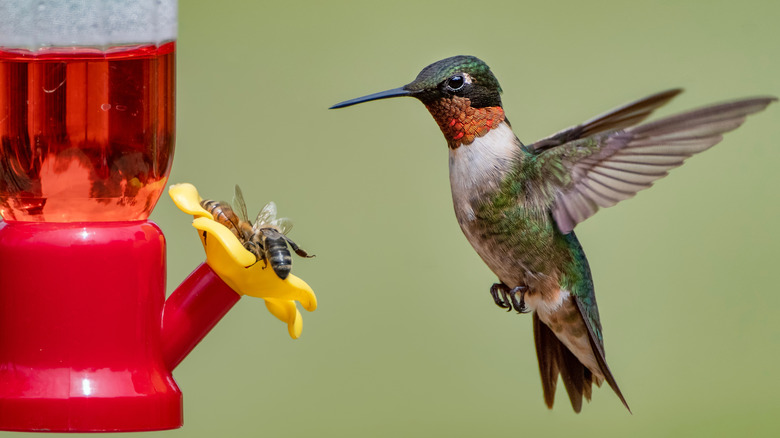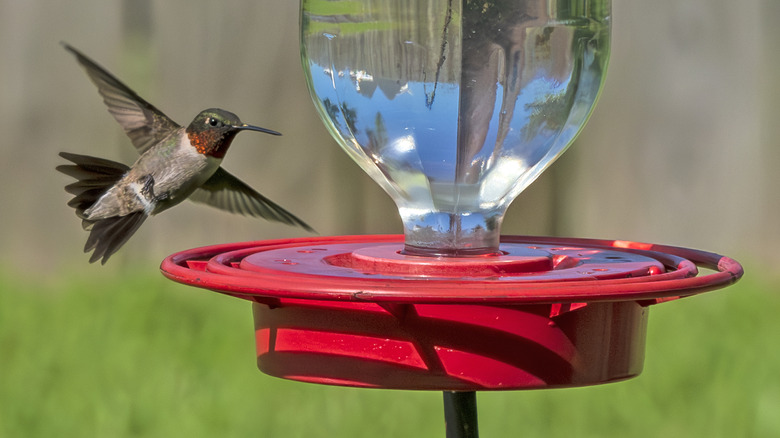The Overlooked Downside To DIY Hummingbird Feeders That You Should Watch For
Watching hummingbirds feed is a thrilling experience. These tiny birds are fascinating to watch and play an important role as pollinators. Planting pollinator-friendly flowers in the garden and adding a DIY hummingbird feeder will encourage them to spend more time on your property. There are several options for DIY hummingbird feeders that are easy to make using common household items. However, there are also advantages and disadvantages to building your own feeder. One of the biggest and most overlooked downside to DIY hummingbird feeders is leaking nectar.
A leaking feeder can cause a range of problems for hummers, from harming their wings to attracting unwanted pests. Proper design and regular cleaning and maintenance can help you avoid leaks and keep these vital pollinators safe in your yard. If this is your first DIY hummingbird feeder, stick with a simple, proven design and carefully follow the instructions for building and installing the feeder.
Dangers of leaking hummingbird feeders
A leaking feeder can cause serious harm to the hummingbirds. The leak may cause the nectar to drip onto the birds' feathers, resulting in the feathers sticking together and potentially falling out. If the feeder is open, it may tip over and coat the bird in nectar. Either of these situations can result in difficulty flying.
Leaky feeders can pose other health risks to hummers. Keeping the feeder and surrounding area clean is more difficult when the hummingbird feeder is leaking. This can result in the growth of mold and bacteria, which are dangerous to these little creatures. The tiny birds can get sick and spread disease to others sharing the same feeder. Stopping leaks and keeping feeders clean is essential for their health.
Another problem caused by leaking nectar is the potential for the liquid to attract other pests, such as bees, wasps, and ants. If you fix the leak and still have an insect problem, keep flying pests away from your hummingbird feeder by providing alternative sources for the pollinators to feed. This can include planting pollinator-friendly plants, such as trumpet honeysuckle, sunflowers, bee balm, or zinnia.
How to prevent hummingbird feeder leaks
The causes of leaks can range from weather damage to a poorly designed or improperly installed hummingbird feeder. However, there are ways to keep your hummingbird feeder from leaking. If you make your own hummingbird food, pouring hot liquid into your DIY feeder can cause the seals to leak. Allowing the liquid to cool to room temperature before filling the feeder helps avoid cracks.
You can also prevent leaking nectar by selecting high quality materials to craft your DIY hummingbird feeder. For example, if using a jar, glass is less likely to warp. When putting it together, make sure to secure all parts tightly. Weather can cause damage to store bought and homemade feeders, so consider taking it down during extreme weather to prevent damage.
Once you have built your feeder, carefully consider where to place it. When installing the feeder, make sure it is level to prevent spillage. Hang the feeder in a shady spot to prevent leaks. Excessive heat and sunlight can cause the nectar to expand and put pressure on the seals. In addition, a shady area of your property will help keep the food from getting too hot. Clean your feeder regularly and inspect it for damage, so you spot leaks quickly.


